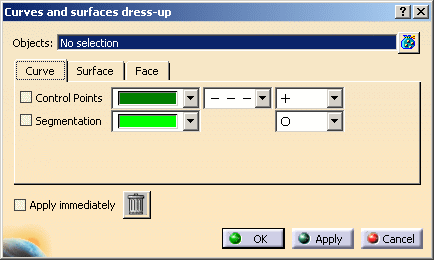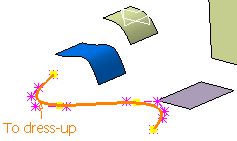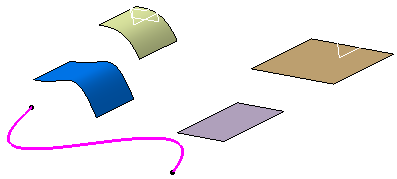Open the FreeStyle_Part_50.CATPart document.
-
Click Dress-Up
 in the Generic Tools
toolbar.
in the Generic Tools
toolbar.
The Curves and surfaces dress-up dialog box is displayed. The dialog box has three tabs: Curve, Surface and Face.- Objects: Select the elements you want
to dress.
The icon lets you edit the list of surfaces selected for
analysis. Click the icon to display the Objects List
dialog box that allows you to remove or
replace the selected elements.
icon lets you edit the list of surfaces selected for
analysis. Click the icon to display the Objects List
dialog box that allows you to remove or
replace the selected elements. - Curve tab: This tab provides options
to dress-up curve elements.

- Control Points: Select this check box to display the control points on the selected curves with the settings as defined in the dialog box. By default this option is deactivated.
- Segmentation: Select this check box to display the segmentation on the selected curves with the settings as defined in the dialog box. By default this option is deactivated.
- Surface tab: This tab provides
options to dress-up surface elements.

-
Control Points: Select this check box
to display the control points on the
selected surfaces with the settings as
defined in the dialog box. By default this
option is deactivated.
This option functions exactly identical to the Control Points option in the Curve tab. - Display control points on edges:
Select this check box to display the control
points only on the edges of the selected
surfaces. By default this option is
deactivated.

When control points on the surface are not displayed, this option allows you to display the control points on the limit edges of the surface only. -
Segmentation: Select this check
box to display the segmentation on the
selected surfaces with the settings as
defined in the dialog box. By default this
option is deactivated.
This option functions exactly identical to the Segmentation option in the Curve tab.- You can define the line type of the segmentation.
-
Iso-curves: Select this check box
to display the number of U and V
isoparametric curves on the selected
surfaces with the settings as defined in the
dialog box. By default this option is
deactivated.
- You can define the color of the isoparametric curves.
- You can define the isoparametric curve style.
- You can define the number of U
and V isoparametric curves from the
NbU and NbV
drop-down lists. The number can be
any number from the list or Order.
Order displays the isoparametric
curves in U and V corresponding to the
internal mathematical order of the
surface.
For example, if the order of the surface is 5 in U and 3 in V, you can see that 5 iso-curves in U direction and 3 in V direction are displayed.
-
Control Points: Select this check box
to display the control points on the
selected surfaces with the settings as
defined in the dialog box. By default this
option is deactivated.
- Face tab: This tab provides options
to dress-up face elements.

- Control Points: Select this
check box to display the control points on
the selected faces with the settings as
defined in the dialog box. By default this
option is deactivated.
This option functions exactly identical to the Control Points option in the Surface tab. - Segmentation: Select this
check box to display the segmentation on the
selected surfaces with the settings as
defined in the dialog box. By default this
option is deactivated.
This option functions exactly identical to the Segmentation option in the Surface tab. - Iso-curves: Select this check
box to display the number of U and V
isoparametric curves on the selected
surfaces with the settings as defined in the
dialog box. By default this option is
deactivated.
This option functions exactly identical to the Iso-curves option in the Surface tab.
- Control Points: Select this
check box to display the control points on
the selected faces with the settings as
defined in the dialog box. By default this
option is deactivated.
- Apply immediately: Select this check box to apply the display changes immediately to the selected elements without clicking Apply.
-
Remove Dress Up
 : Select the elements
and click icon to remove all the dress-up elements
from selected elements at one time.
: Select the elements
and click icon to remove all the dress-up elements
from selected elements at one time.
- Objects: Select the elements you want
to dress.
-
Select the curve.
-
In the Curve tab, select the Control Points and Segmentation options. You can change the color, linetype and style also.
-
Click Apply.

-
Select the Apply immediately check box.
-
Select a surface.
-
In the Surface tab, select the Control Points and Segmentation options. You can change the color, linetype and style also. You can see that the display options are applied immediately on the selected surface.

-
Clear the Control Points check box.
-
Select the Display control points on edges and Iso-curves options.
-
In the NbU and NbV list, select the number of isoparametric curves. In this case select Order.

-
Select a face.
-
In the Face tab, select the Control Points, Segmentation and Iso-curves options. You can change the color, linetype and style also.

The control points displayed are of the underlying surface of the face.
-
Click OK. You can see that the dress-up elements are displayed as selected in the Curves and surfaces dress-up dialog box.

-
Click Dress-Up again.
-
Select the elements from which you want to remove the dress-up features. In this case select all the elements.
-
Click Remove DressUp
 .
.

-
Click OK.
-
There are three states of the options available in the Curves and surfaces dress-up dialog box:
- Not selected: When the selected elements do not have any dress-up feature defined, the options in the Curves and surfaces dress-up dialog box are not selected.
- Selected: When the selected elements have the same parameters (color, linetype, symbol and selection of the option) for the defined dress-up feature, such options are selected in the Curves and surfaces dress-up dialog box.
- Undefined: When the selected elements
have the different parameters (color,
linetype, symbol and selection of the
option) for the defined dress-up feature,
such options are in undefined state in the Curves and surfaces dress-up
dialog box.

-
The option will remain in undefined state till you change it.
-
You can press F8 key to change the selection state. After selecting elements, press F8 and modify the parameters you want to. In this state your existing selection will not be deselected even if you click anywhere in the 3D area. Press F8 again to go back to the selection state.
-
The Dress-Up command can be launched when another command (Styling Extrapolate, Extend, etc.) is running. The other command is temporarily deactivated and you can apply the dress-up features to elements. After you click OK in the Dress-Up command, the previous command is reactivated.
-
If dress-up is applied to an element, while editing the control points of this element, the dress-up representation of the control points and control points on edges of this element is hidden.